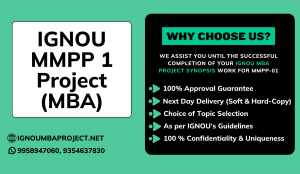The Indira Gandhi National Open University’s (IGNOU) Master of Business Administration (MBA) curriculum includes an IGNOU MBA Project. It acts as a practical application of the academic principles covered in the course. The project is related to the course code MS-100 and is required for students to complete their MBA degrees.
The primary goal of the initiative is to help students develop research and analytical skills by allowing them to investigate real-world business problems. Students choose a specialized topic within their field of study, such as finance, marketing, human resources, operations, or another management domain. This IGNOU assignment requires students to perform extensive research, analyze data, and present actionable recommendations or solutions based on their findings.
The project is divided into many steps, including topic selection, summary preparation, IGNOU approval, research, and lastly writing and submitting the project report. A guide or supervisor approved by IGNOU mentors the student throughout the procedure.
What are the most common mistakes students make while selecting an IGNOU MBA Project topic?
Selecting the right project topic is a critical step in completing the IGNOU MBA project successfully. However, many students make common mistakes that can impact the overall quality of their project. Here are some of the most frequent errors:
1. Choosing a Topic That Is Too Broad
- Students often select overly generalized topics, making it difficult to focus their research and provide in-depth analysis.
- Solution: Narrow the topic to a specific issue or case study within a particular industry or domain.
2. Picking a Topic outside Their Area of Specialization
- Selecting a topic unrelated to their MBA specialization (e.g., finance students choosing a marketing topic) can lead to challenges in understanding and justifying the research.
- Solution: Ensure the topic aligns with the student’s chosen specialization for better comprehension and relevance.
3. Lack of Interest in the Topic
- Many students choose topics they find uninteresting, often based on external suggestions, which can reduce their motivation to complete the project effectively.
- Solution: Pick a topic that aligns with personal interests or career goals.
4. Ignoring the Practical Feasibility
- Some students select topics requiring data or resources that are difficult to access, making the research impractical.
- Solution: Assess the availability of data, resources, and time before finalizing the topic.
5. Overlooking IGNOU Guidelines
- Students often fail to consult IGNOU’s project guidelines, resulting in the selection of topics that do not meet the requirements.
- Solution: Review the IGNOU MBA project handbook and guidelines thoroughly before choosing a topic.
6. Selecting a Common or Overused Topic
- Opting for topics that have been extensively researched can make it difficult to provide fresh insights.
- Solution: Research current trends and challenges in the industry to select a unique or innovative topic.
7. Choosing a Topic without Scope for Research
- Some students choose topics that lack sufficient scope for analysis, making it difficult to develop meaningful findings.
- Solution: Evaluate the topic’s potential for data collection, analysis, and conclusion.
8. Rushing the Topic Selection Process
- Many students finalize a topic in haste without giving it proper thought or considering its long-term feasibility.
- Solution: Spend adequate time brainstorming, consulting with guides, and reviewing options before deciding.
Sample of IGNOU MBA Project topics
- Organizational Culture And Job Satisfaction Of Employees Working In Call Centre
- Supply Chain Management In Honda Cars India Ltd (Hcil)
- Customer Preferences Towards Life Insurance Products Of Lic
- A Study On Preferences Of Investors On Various Investment Opportunities
- Investors’ Perceptions And Preferences Towards Indian Capital Market Instrument: A Case Study Of Derivatives
- Impact Of Involvement And Employee Motivation On Job Satisfaction Of Male And Female Employees
Why do many students fail to submit a properly formatted synopsis for the IGNOU MBA Project?
Reasons Why Many Students Fail to Submit a Properly Formatted Synopsis
Lack of Familiarity with Guidelines
Students often fail to review the formatting and structural guidelines provided by institutions like IGNOU, leading to errors in presentation.
Procrastination
Many students delay working on their synopsis until the deadline is near, leaving little time to focus on formatting and details.
Inadequate Knowledge of Academic Writing
Students may struggle with organizing their synopsis into required sections, such as the introduction, objectives, methodology, and expected outcomes.
Limited Technical Skills
A lack of proficiency in using word processing tools can result in difficulties with setting margins, line spacing, font styles, and other formatting elements.
Misunderstanding Structure Requirements
Some students fail to differentiate between a synopsis and a full report, leading to an improperly structured document.
Absence of Proper Guidance
Irregular consultations with supervisors leave students unclear about expectations and corrections required for a well-formatted submission.
Errors in Citation and Referencing
Many students are unaware of how to format references in styles like APA or MLA, which results in inconsistencies.
Rushing Without Proofreading
In their haste to meet submission deadlines, students often skip proofreading, leaving formatting errors and inconsistencies unchecked.
Over-Reliance on Templates
Students may use old templates that do not comply with current formatting requirements, resulting in errors.
Lack of Attention to Detail
Small but critical elements, such as page numbering, proper headings, and alignment, are often overlooked due to carelessness.
How to Avoid These Mistakes
- Thoroughly review the guidelines and follow them step-by-step.
- Begin work early to allow time for corrections.
- Consult supervisors regularly and seek feedback.
- Use formatting tools or resources for citations and proper structuring.
- Proofread the synopsis before submission to ensure all elements are in order.
What happens if a student does not follow the IGNOU project guidelines?
If a student does not follow the IGNOU project guidelines, it can lead to significant consequences that may hinder the completion of their degree. Here are the key outcomes:
1. Rejection of Synopsis or Project Report
- Consequence: A poorly prepared synopsis or project report that deviates from the prescribed guidelines is likely to be rejected.
- Impact: The student will need to rework and resubmit, leading to delays in project completion and additional effort.
2. Delay in Degree Completion
- Consequence: Failing to adhere to guidelines, such as missing deadlines or submitting incomplete documentation can prolong the approval and evaluation process.
- Impact: This can delay the award of the degree, potentially affecting career plans or further education opportunities.
3. Poor Evaluation Scores
- Consequence: Deviations from the formatting, structure, or quality standards outlined by IGNOU can result in lower grades or marks for the project.
- Impact: Poor scores may affect the overall academic performance and GPA.
4. Need for Resubmission
- Consequence: If the project fails to meet IGNOU’s academic or ethical standards (e.g., plagiarism), the student will be required to redo and resubmit the project.
- Impact: This can be time-consuming and costly, as additional resources and effort are needed for resubmission.
5. Disqualification Due to Plagiarism
- Consequence: Not following guidelines on originality (e.g., plagiarism rules) can lead to disqualification or rejection of the project.
- Impact: This could result in the student being required to submit a new project, wasting months of effort.
6. Non-Acceptance by Examiners
- Consequence: Projects that do not follow the prescribed structure, such as missing sections (e.g., introduction, objectives, methodology, findings, and conclusion), may not be accepted by the evaluator.
- Impact: This can lead to a need for corrections, delaying the process further.
Check Our: IGNOU Handwritten Assignment
7. Difficulty in Approval of Final Project
- Consequence: IGNOU requires the project to strictly adhere to guidelines for formatting, word count, references, and documentation. Failure to comply may result in multiple rounds of feedback and resubmissions.
- Impact: It increases stress and creates unnecessary hurdles in the process.
8. Loss of Professional Impression
- Consequence: Submitting a project that does not meet professional standards can reflect poorly on the student during viva voce or external evaluations.
- Impact: This may reduce the credibility of the student’s work in front of examiners.
9. Financial and Time Costs
- Consequence: Resubmitting the project may involve additional costs for printing, re-evaluation fees, or hiring external help for corrections.
- Impact: It places unnecessary financial and time burdens on the student.
10. Impact on Career or Academic Progress
- Consequence: Delays or poor-quality projects can adversely affect internship placements, job applications, or further studies.
- Impact: Students may lose out on professional or academic opportunities due to incomplete or poorly executed projects.
Why do students often misunderstand the objectives of the IGNOU MBA Project work?
Students often misunderstand the objectives of their project work due to several factors, leading to a misalignment with the core purpose of the project. One common reason is a lack of thorough understanding of the project guidelines provided by institutions like IGNOU. Without reviewing these guidelines in detail, students may fail to identify the specific objectives required for their research. Additionally, many students confuse broad goals with specific objectives, which results in vague or overly ambitious project aims. This confusion is often exacerbated by inadequate guidance from supervisors or a lack of regular communication, leaving students unclear about the expected outcomes.
Another issue arises when students select topics that are too broad or irrelevant to their academic discipline, making it difficult to frame focused and meaningful objectives. Additionally, a reliance on old project templates or past examples, without fully understanding the rationale behind the objectives, often leads to misunderstandings. Limited critical thinking skills also play a role, as students may not fully grasp how to define clear, measurable objectives based on their research question. Lastly, many students approach their projects with the aim of simply completing the task rather than focusing on the learning experience, which results in poorly articulated objectives that fail to guide the research effectively.
Conclusion
The IGNOU MBA Project, MS-100, is one of the final steps a student takes to showcase his research, analytical, and practical skills. However, students usually commit errors while choosing topics, preparing synopses, following guidelines, and understanding the project objectives. Therefore, for a smooth project experience, a student should start with a focused and relevant topic that must align with his specialization and interest. A student can avoid potential pitfalls by thoroughly reviewing the IGNOU guidelines, regularly meeting with supervisors, and practicing effective time management.
Students should first focus on the objectives of their project work, framing them to be clear, specific, and aligned with the research goals. Misunderstandings in this area can lead to a misdirected project, affecting both quality and outcomes. Originality, feasibility, and adherence to academic standards, including proper formatting and referencing, ensure a high-quality submission that meets IGNOU’s expectations.
By addressing these challenges proactively and committing to diligent research and preparation, students can complete their IGNOU MBA Project or IGNOU MCOM Project and gain invaluable skills that enhance their academic and professional journey.






